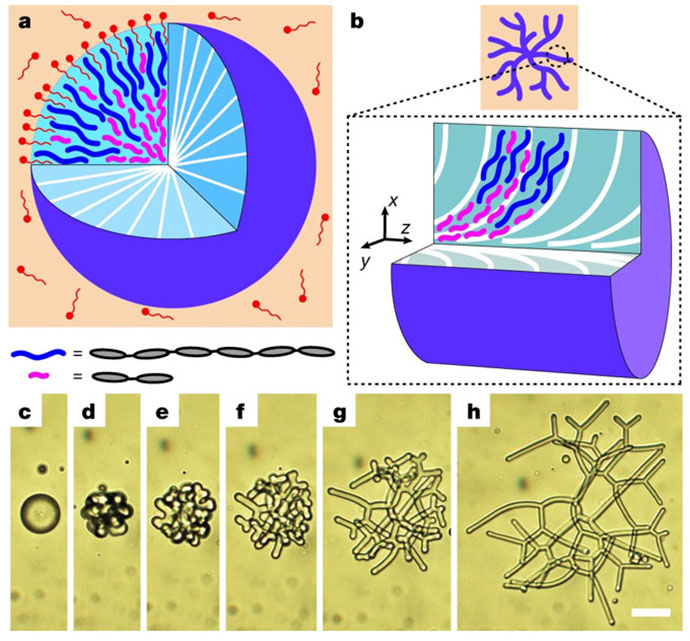 With few exceptions, polydispersity or molecular heterogeneity in matter tends to impede assembly Shape transformations of liquid droplets, for example, are readily understood on the basis of homogeneous material responses. Here, Yodh and Yang in IRG-3 studied drops filled with polydisperse nematic liquid crystal oligomers (NLCOs). They discovered that chain-length heterogeneity in the drops promotes reversible shape transitions to a rich variety of non-spherical morphologies with unique internal structure. Control of oligomer chain-length distribution, temperature, and surfactant concentration alters the balance between liquid crystal elastic energy and interfacial energy, and drives formation of nematic structures that range from roughened spheres to ‘flower’ shapes to branched filamentous networks with controllable diameters (Bottom c-h). The branched structures with confined liquid crystal (LC) director fields were produced reversibly and were converted into liquid crystal elastomers by curing. The insight that chain-length polydispersity leads to length-dependent spatial segregation, i.e., towards and away from LC defects (Top a,b), suggests a qualitative new route for encoding network structure and function in soft materials. New research is studying assembly of nanoparticles introduced into these drops.
With few exceptions, polydispersity or molecular heterogeneity in matter tends to impede assembly Shape transformations of liquid droplets, for example, are readily understood on the basis of homogeneous material responses. Here, Yodh and Yang in IRG-3 studied drops filled with polydisperse nematic liquid crystal oligomers (NLCOs). They discovered that chain-length heterogeneity in the drops promotes reversible shape transitions to a rich variety of non-spherical morphologies with unique internal structure. Control of oligomer chain-length distribution, temperature, and surfactant concentration alters the balance between liquid crystal elastic energy and interfacial energy, and drives formation of nematic structures that range from roughened spheres to ‘flower’ shapes to branched filamentous networks with controllable diameters (Bottom c-h). The branched structures with confined liquid crystal (LC) director fields were produced reversibly and were converted into liquid crystal elastomers by curing. The insight that chain-length polydispersity leads to length-dependent spatial segregation, i.e., towards and away from LC defects (Top a,b), suggests a qualitative new route for encoding network structure and function in soft materials. New research is studying assembly of nanoparticles introduced into these drops.
Wei, W. S., Xia, Y., Ettinger, S., Yang, S. and Yodh, A. G. Molecular heterogeneity drives reconfigurable nematic liquid crystal drops. Nature 576, 433-436 (2019).
